Spring Foray to Slate Run Metro Park
Pickaway County, Ohio
June 14, 2014
Slate Run Metro Park is a beautiful 1700+ acre park in Pickaway County with a variety of habitats including forest and grasslands. An intermittent stream, Slate Run Creek, runs through the woods. Its shale and soil banks provide good substrate for mosses. Trees on the edges of the forest and also scattered in the sunny recreational park area are the principal lichen substrates. Over a dozen OMLA members and friends came to explore the park on this lovely late Spring Saturday.
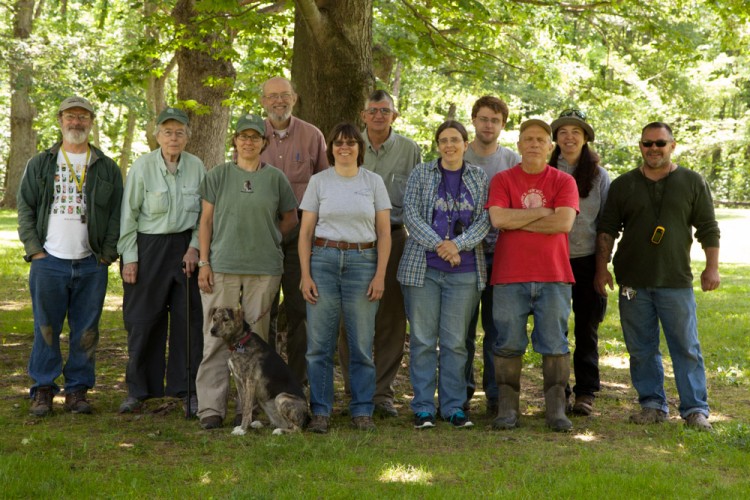
Happy moss and lichen hunters at Slate Run Metro park.
Boulders in the woods are a good place to find mosses.
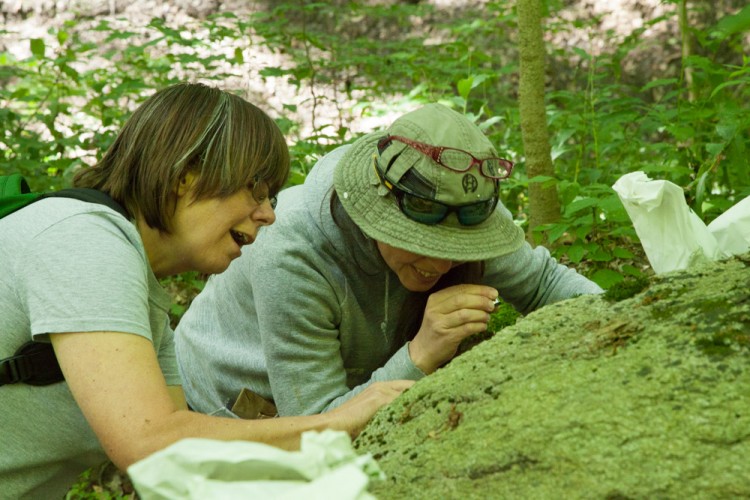
Janet and Suzanne discover something small and green.
Members of the moss genus Orthotrichum are tufted dark green cushion mosses. Different species are typically found either on bark or rocks. The sporophytes are short, and their bases are closely surrounded by the upper leaves. The peristome is in one series, consisting of of 8 (sometimes splitting into 16) triangular, sharply reflexed teeth.

Orthotrichum on the rock.
Soil on the bluffs of the banks of the intermittent stream were fairly well occupied with mosses. One of these is a robust cushion moss (acrocarp) with fairly broad leaves that are toothed all around the margin. It’s Plagiomnium ciliare.
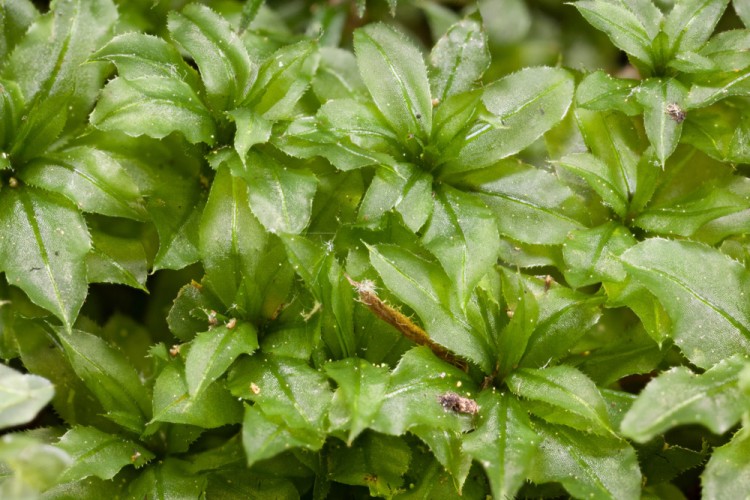
Plagiomnium ciliare has elliptical leaves that are finely toothed all around.
Trees constitute the best lichen substrate in wooded areas free of large expanses of boulders or open bluffs. Here, Diane and Janet watch as Ray scrutinizes bark.
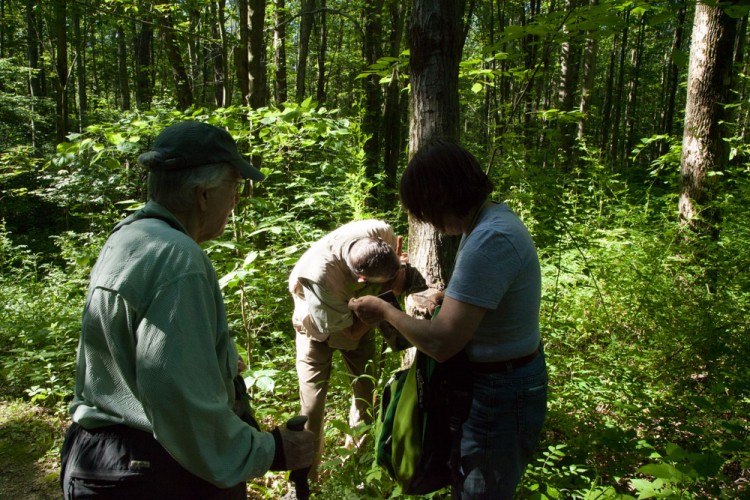
Ray examines bark for lichens.
Members of foliose lichen genus Punctelia are frequently encountered on trees in Ohio. One species is especially common: Punctelia rudecta, which is gray, with moderate-sized marginal lobes, and prominent isidia (minute projecting asexual reproductive structures).
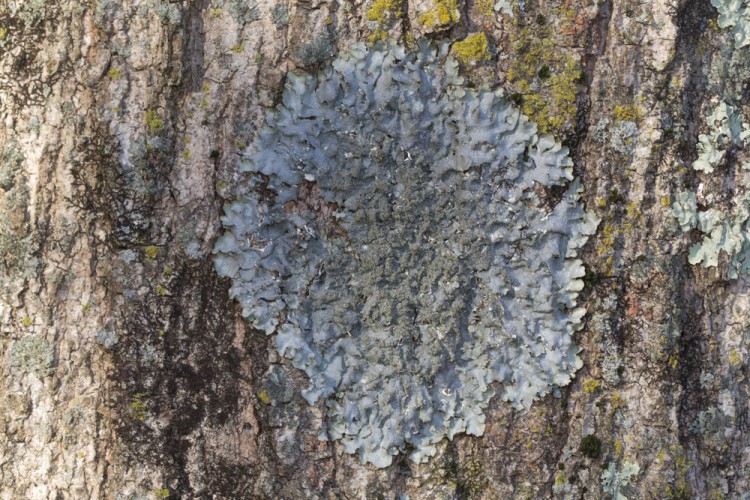
Punctelia rudecta is a moderate-size gray foliose lichen.
A related species that lacks either isidia or soredia is Puctelia bolliana. Note the lobulate thallus.
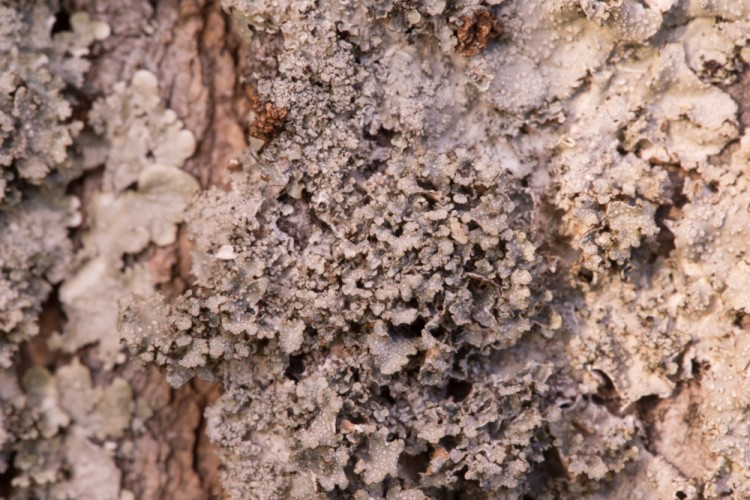
Punctelia bolliana is a foliose lichen with conspicuous lobules.
Way in the woods (a little bushwhacking here) lies an amazing little buttonbush swamp. It was pretty squishy walking aroind here, but worth the trouble. We saw this tangle mass of little straps-shaped leaves belonging to an aquatic liverwort, Riccia fluitans. This species is very common in home aquariums. It’s nice to see it in the wild.
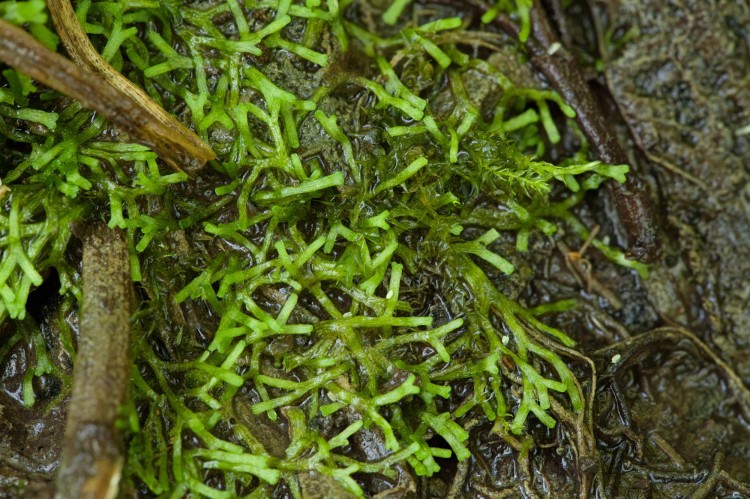
Riccia fluitans is an aquatic liverwort.
In the same swampy spot in the woods, this is not a bryophyte but a vascular plant that seems to be trying very hard to be one. We saw “star duckweed,” Lemna trisulca. This crazy duckweed, looks like little airplanes crashing into one another.
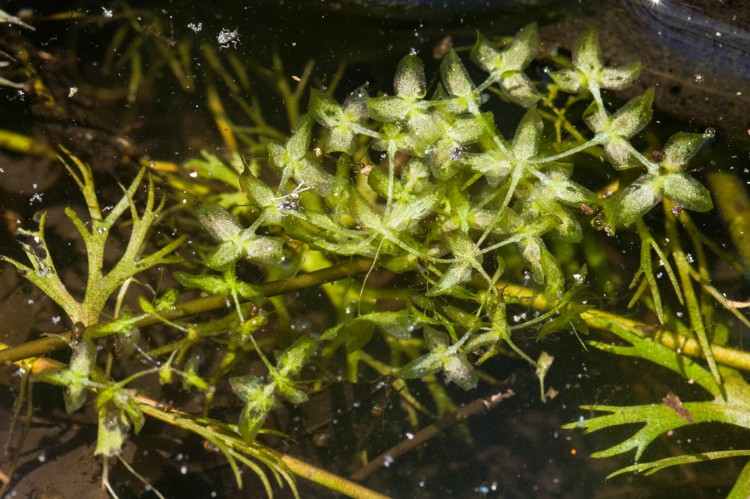
Star duckweed looks like a crowded airport from above.
OMLA members are good friends, always happy to talk about life, the universe, and everything. Usually this consists of updating one another on their recent outings in search of mosses and lichens.
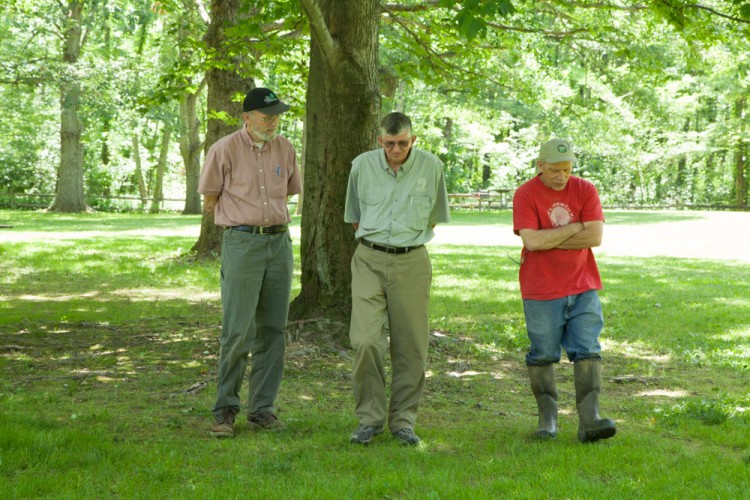
Jim, Ray and Bill discussing their recent experiences hunting mosses and lichens.
For further information about this very excellent foray, look in Volume 11 (2014) of the association’s newsletter, OBELISK.
Lichens of the 2014 Spring Foray in Pickaway County
* = new county record
Candelaria concolor
Canoparmelia crozalsiana*
Cladonia coniocraea*
C. macilenta*
Flavoparmelia caperata
Flavopunctelia flaventior
Leptogium juniperinum*
Myelochroa aurulenta
Parmelia squarrosa*
P. sulcata
Parmotrema hypotropum
P. reticulatum*
Phaeophyscia adiastola*
P. hirsuta*
P. rubropulchra
P. squarrosa*
Physcia americana*
P. millegrana
P. stellaris
Physciella chloantha*
Physconia detersa
Punctelia caseana*
P. missouriensis*
P. rudecta
Pyxine sorediata*
P. subcinerea*
Xanthomendoza fallax
Bryophytes of the 2014 Spring Foray in Pickaway County
* = new county record
Mosses
Amblystegium varium
Anomodon attenuatus
A. minor
A. rostratus
Atrichum angustatum
Barbula unguiculata
Brachythecium acuminatum
B. campestre
B. laetum
B. plumosum*
B. rotaeanum*
B. rutabulum
B. salebrosum
Bryhnia novae-angliae*
Bryoandersonia illecebra*
Calliergonella lindbergii
Campylium chrysophyllum
C. radicale*
Ceratodon purpureus
Clasmatodon parvulus*
Ctenidium malacodes*
Dicranum montanum*
D. viride*
Diphyscium foliosum
Ditrichum pusilum*
Entodon seductrix
Eurhynchium hians
Fissidens bryoides*
Grimmia pilifera*
Gymnostomum aeruginosum*
Haplocladium microphyllum
Haplohymenium triste*
Hedwigia ciliata
Hygroamblystegium tenax
Hyophila involuta*
Hypnum curvifolium
Leptodictyum riparium
Leskea gracilescens
Leucodon julaceus
Lindbergia brachyptera*
Orthotrichum ohioense
O. pusillum
O. stellatum
O. sordidum*
Plagiomnium ciliare
Plagiomnium cuspidatum
P. ellipticum*
Plagiothecium cavifolium
P. denticulatum
Platygyrium repens
Polytrichastrum ohioense*
Polytrichum piliferum*
Pylaisiadelpha tenuirostris*
Rhizomnium punctatum
Rhynchostegium serrulatum
Schistidium apocarpum*
Sematophyllum adnatum*
S. demissum*
Syntrichia papillosa
Taxiphyllum taxirameum
Thuidium delicatulum var. radicans*
Liverworts
Calypogeia muelleriana*
Cephalozia lunulifolia*
Cololejeunea biddlecomiae*
Frullania eboracensis*
Lophocolea heterophylla*
Nowellia curvifolia*
Porella playtyphylloidea
Riccia fluitans*
Scapania nemorea*
